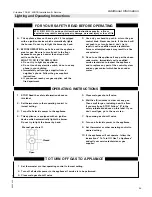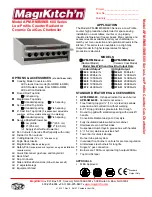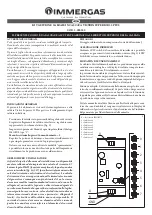
90
5600 332 v1.3
Vitodens 100-W, WB1B Installation & Service
Burner Program Sequence of Operation
(continued)
Phase 0: Stand by
Complete shutdown until the next call for heat.
In this phase both the combination gas valve and
the blower are not energized.
Phase 1: Stand-still status test (blower)
A call for heat initiates internal blower sensory
communications to confirm that the blower is
truly in stand-still position. Blower speed
measured must be < 300 rpm within a 70
second period.
Phase 2: Pre-purge speed test
Controller sends and receives signal to / from
fan speed controller to verify maximum rpm of
the blower.
Phase 3: Pre-purge
Pre-purge cycle starts within the pre-programmed
timing. Pre-purge timing is in addition to previous
phase (2). The fan speed must be greater than
1500 rpm.
Phase 4: Pre-ignition
The ignition spark is initiated and controlled.
Phase 5: Ignition / safety timing
The gas valve opens during the safety timing
period (4.8 secs.). If a flame is detected, this
phase ends immediately in < 4.8 secs. If the
flame is not established after 3 trials, the burner
will lock out and will require a manual reset.
Phase 6: Flame stabilization
Controller required time for flame stabilization.
Phase 7: Forced low-fire
The controller will go into low-fire until required
modulation signal (high-low) is processed (eg.
boiler actual water temperature).
Phase 8: Burner operation
At the end of the flame stabilization period
(5 sec.), a release for modulation occurs and
the burner temperature controller will take over
from the flame safeguard. Forced shutdown
after 24 hours continuous operation.
Phase 9: Post-purge speed test
Both gas valves are closed during this phase.
End call for heat.
Post-purge occurs during the programmed
period. If the fixed high limit trips during
normal operation, the blower will purge for
15 minutes to cool the heat exchanger.
Phase 10: Combination gas valve proof of closure test
If during the normal operation of the burner a
controlled (or uncontrolled) shut-down occurs,
a complete mechanical and electrical gas
valve proof of closure test will be performed
by the flame safeguard. After a successful
mechanical and electrical proof of closure
test, the flame safeguard will expect that the
flame is not present. If, however, the flame
existed for a period of >30 seconds, the flame
safeguard will go into permanent lock-out.
Additional Information











































